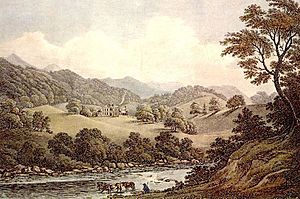John Warwick Smith facts for kids
John "Warwick" Smith (born July 26, 1749 – died March 22, 1831) was a British artist. He was famous for his beautiful watercolour paintings of landscapes and for illustrating books. People often called him "Warwick" Smith because of his connection to the Earl of Warwick, or "Italian" Smith because of his many trips to Italy.
Contents
Early Life and Artistic Journey

John Smith was born in a small village called Irthington, near Carlisle, in Cumberland. His father was a gardener for the Gilpin family. This connection was very lucky for John. It allowed him to study art with Sawrey Gilpin, who was an animal painter.
John became very good at drawing detailed landscapes. He worked on a book called Select Views in Great Britain. He also gained the support of George Greville, 2nd Earl of Warwick. This support, called patronage, helped him a lot.
Travels to Italy
Thanks to the Earl of Warwick, John Smith was able to travel to Italy. He stayed there from 1776 to 1781. While in Italy, he met other British artists like Francis Towne and William Pars.
His time in Italy greatly influenced his art. Before this, watercolour paintings often used simple washes of colour. John Smith started using new ways to add colour that made his paintings more lively and beautiful. People really admired his new style, especially in his paintings of Italian scenes.
He returned to England in 1781 with Francis Towne. They traveled through the Italian lakes and Switzerland together.
Settling in Warwick and Welsh Tours
After his travels, John Smith settled in Warwick, England. From 1784 onwards, he often visited Wales to paint its landscapes. He also explored the Lake District in the late 1780s and early 1790s.
In 1783, he married Elizabeth Gerrard. He visited Italy again in 1785 and 1786, this time with Lord Warwick. Lord Warwick bought many of John Smith's artworks over the years.
On one of his trips to Wales, after 1788, Smith traveled with Lord Warwick's brother, Robert Fulke Greville, and another artist named Julius Caesar Ibbetson. They spent time at Hafod, a beautiful estate near Aberystwyth. Hafod was owned by Thomas Johnes, who loved books.
Illustrated Books and Exhibitions
John "Warwick" Smith's artwork was featured in several important books. These books helped share his beautiful landscape paintings with more people through engravings.
Notable Illustrated Works
- Select Views in Italy (1792–1796): This book showed many of his Italian landscapes.
- Views of the Lakes of Cumberland (1791–1795): This book featured twenty aquatints (a type of print) made by James Merigot from Smith's paintings of the Lake District.
- William Byrne's Britannia Depicta: Another book that included his engravings.
- William Sotheby's Tour through Wales (1794): This book included poems and engravings from Smith's drawings. The author, Sotheby, mentioned that the book was published to help the artist, praising Smith's "accurate and masterly pencil."
Later Career and Leadership
In 1807, John Smith moved to London. That same year, he began showing his art with the Royal Watercolour Society. He had joined this society two years earlier. He was a very active member, contributing many paintings to their exhibitions until 1823.
He held important leadership roles within the society:
- He was elected president three times: in 1814, 1817, and 1818.
- He served as secretary in 1816.
- He was treasurer in 1819, 1821, and 1822.
John "Warwick" Smith passed away in London on March 22, 1831. He was buried in St George's burial-ground. His work helped change how watercolour painting was seen, making it a more respected art form.
Images for kids
-
Cetara on the bay of Salerno




